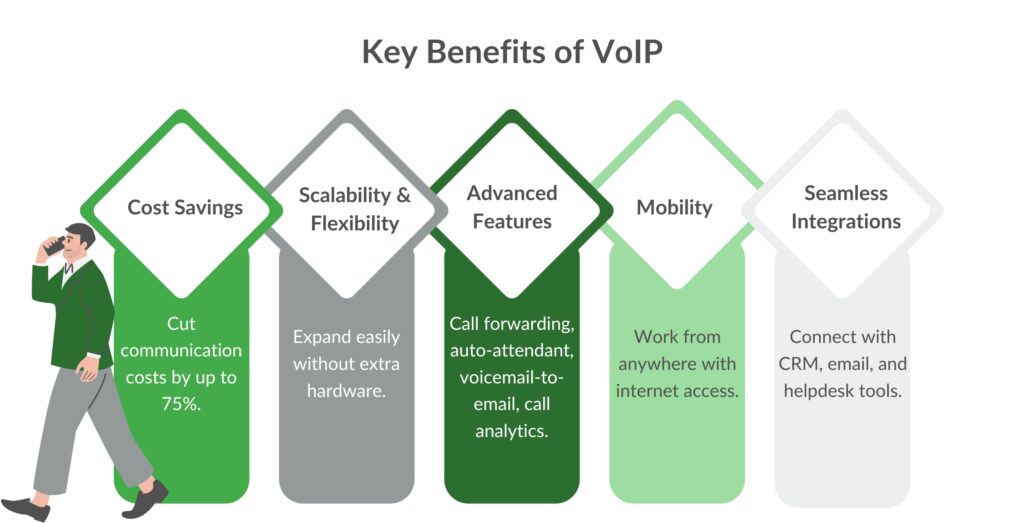How VoIP Can Elevate Your Business Communication

Introduction
How we communicate with others is so ingrained in our daily lives that we seldom pause to consider its significance. This is especially true when it comes to business communication. After all, organizations aren’t faceless entities — they’re composed of real people working together as a team.
Effective communication influences every aspect of a company, from processes and efficiency to employee morale and customer satisfaction, significantly enhancing decision-making and problem-solving capabilities.
In this blog post, we talk about VoIP and why it’s an excellent choice for businesses looking to elevate their internal and customer communications. From what it is to market trends for 2025, you’ll learn if a VoIP phone system makes sense for your business.
What Is VoIP and How Does It Work?
VoIP is an internet-based phone service. Rather than transmitting voice conversations through traditional phone lines, VoIP digitizes and routes the conversations through internet lines.
Computer software records your voice and codes it into a digital signal, which is then sent over the Internet. This process happens instantaneously.
Here are some benefits of VoIP at a glance:
- Reduced costs: Cost is a primary reason businesses are switching to VoIP. Most VoIP providers charge a monthly per-user fee rather than a fee based on the number of minutes everyone in the company spends on the phone.
- Flexibility and scalability: VoIP’s scalability is another advantage, making it an attractive proposition for growing businesses. A cloud-based solution makes it simple to add phone lines when new employees are hired.
- Unified communications features: One of the significant advantages of VoIP is its part in the larger picture of United Communications as a Service (UCaas). UCaaS is a cloud-based solution that integrates various communication and collaboration tools into a single platform, like video, chat, and conferencing.
Why VoIP Is Essential for Businesses in 2025
While some organizations still use traditional PBX, VoIP systems are quickly becoming the preferred option thanks to their affordability, flexibility, and advanced features.
PBX technology is evolving, and the transition from traditional PBX to VoIP is happening quickly. This is especially true in remote work environments, where clear and consistent communication is essential. Without the physical presence of colleagues, remote teams must rely on digital tools to stay connected and collaborate effectively.
VoIP has emerged as a key enabler of this process, offering features that support instant communication, collaboration, and seamless integration with other tools.
Another major adoption trend is AI’s integration in VoIP systems. This integration is projected to grow by 35%, bringing features like real-time transcription, call sentiment analysis, and intelligent call routing to the forefront of business communication.
Key Benefits of VoIP for Business Communication
- Cost Savings
One of the most compelling reasons businesses switch to VoIP is the potential for cost savings. A VoIP service can drastically reduce telephony costs by routing calls over the internet. Specifically, VoIP services significantly reduce international calling costs through several key methods. For example, Wi-Fi calling eliminates international roaming charges while traveling, and VoIP bypasses expensive international gateways by routing calls over the Internet. Businesses that switch to VoIP can save up to 75% on communication costs, making it a wise financial decision.
- Scalability & Flexibility
Traditional phone systems, relying on physical infrastructure and hardware, often pose challenges in scaling up. VoIP’s beauty lies in its simplicity and flexibility. Since it operates over the internet, expanding your communication system to include more phone lines or accommodate a growing number of users is straightforward and hassle-free. There’s minimal need for additional hardware or extensive infrastructure modifications. This ease of scalability ensures that your communication system can evolve smoothly alongside your business.
- Advanced Communication Features
VoIP offers various powerful features that can significantly enhance efficiency and connectivity within your business. Some of the more advanced features include:
Call forwarding: Call forwarding enables businesses to redirect incoming calls to another phone number user who is available at that moment, which doesn’t leave any call unanswered and provides relevant information to the caller.
Auto-attendant: Auto-attendant is a multi-level menu system that helps to answer, escalate, and route incoming calls, connect customers to their desired recipients, and handle their problems. It improves efficiency by effortlessly routing callers to the correct department, saving time and money.
Voicemail-to-email: The voicemail-to-email feature automatically forwards voicemails from your business phone system to your email. It converts voicemails into text messages and sends them directly to your email, allowing you to read the content of voice messages without listening to them.
Call analytics: Call analytics is a category of tools that measures individual and aggregate data related to incoming and outgoing calls. Call tracking includes inbound call volume, call time, hold time, answer speed, and many more metrics.

These features support internal teams and customer service by enabling flexible communication across locations.
- Improved Mobility & Remote Work
Millions of individuals are working remotely, and this new style of work is becoming more and more mainstream. With VoIP, employees can make or receive calls anywhere with an internet connection. It enables employees to remain connected at all times and make and receive phone calls no matter their situation as long as they have an internet connection.
- Integration with Other Business Tools
Most VoIP systems offer prebuilt integrations with email programs and contact databases. The options may vary based on the subscription tier. In cases where the software doesn’t connect natively, you may be able to use a third-party app connector tool. Otherwise, vendors may provide APIs. This way, you can connect your business-critical tools like CRM and helpdesk systems.
Common Concerns and How to Address Them
We know that Voice over Internet Protocol (VoIP) systems send calls over the Internet and rely on your local network and bandwidth capacity. Therefore, a weak link in the chain can negatively impact voice quality. Here are the most common VoIP issues to be aware of and fix:
Call Quality & Reliability: Since VoIP calls are transmitted in real-time as data packets, any disruptions to voice packets reaching a destined IP address will get heard as choppy, distorted, or delayed audio on calls. If you’re experiencing call quality issues, look out for these common culprits:
- Insufficient Bandwidth
- Network Jitter
- Packet Loss
- Improper quality of service Settings
Start by checking your internet bandwidth. Insufficient upload/download speeds are the most common cause of choppy VoIP calls.
Run speed tests to ensure you meet your VoIP provider’s bandwidth recommendations.
Next, test your network for issues like high latency/jitter or packet loss during calls and troubleshoot accordingly. This may involve upgrading router firmware or contacting your Internet Service Provider (ISP).
Security: VoIP can introduce new threats to your environment, requiring more security awareness training across your organization to reduce the risk of falling victim to malicious software and social engineering. Thankfully, there are ways to protect yourself from an attack in the first place and ways to mitigate the damage should an attack occur, such as employee awareness programs and incident response solutions.
Implementation & Training: The success of a VoIP system significantly depends on how your employees accept and adapt to it. Your employees may hesitate or find it challenging when you suddenly shift from traditional phone systems to a VoIP-based setup. Such resistance often occurs due to unfamiliarity with the new system, fear of technology, or concerns about the system’s efficacy. Some solutions would be to:
- Offer comprehensive training sessions.
- Provide ongoing support
- Choose systems with user-friendly interfaces.
Real-Life Use Cases and Success Stories
Scaling from Small Business to Enterprise
Small businesses often face challenges as they grow, especially with outdated landline systems that can’t handle increased call volume or provide modern features. By adopting VoIP, companies can integrate capabilities like automated answering, call forwarding, and remote access without overhauling their entire phone system. VoIP works alongside existing hardware, offering a cost-effective way to scale communication. Employees can manage customer inquiries, orders, or support calls from any device, improving efficiency and customer service. This seamless upgrade allows businesses to grow while keeping overhead low and operations smooth.
Supporting Hybrid Teams
As remote work became more common, many businesses struggled to communicate seamlessly between in-office and remote employees. Traditional phone systems weren’t designed for flexibility, often leading to missed calls and difficulty staying connected. By adopting VoIP, organizations enabled remote workers to use a single communication platform for calls, video conferencing, and voicemail, accessible from any device. This cloud-based solution allowed employees to stay in touch with teams, clients, and customers, regardless of location. VoIP’s flexibility enhanced collaboration, improved response times, and increased productivity, making it easier for businesses to support a distributed workforce without significant infrastructure changes.
Tips for Choosing the Right VoIP Provider
Choosing a business VoIP service can be overwhelming, with many options. To simplify this decision-making process, here are the pivotal factors to consider when selecting the optimal VoIP provider for your business.
- Assess Your Business Needs
Many businesses often rush into exploring VoIP phones without first outlining their specific requirements from a VoIP phone system. This tendency usually prolongs their research and leads to confusion during decision-making. Consider your number of users, desired features, and call volume to understand better what your business might require from a VoIP phone system.
- Compare Pricing Models
Evaluate each VoIP provider’s pricing structure and consider whether they offer affordable plans that align with your budget. Look for transparent providers about their pricing, including any additional fees or charges. Compare the pricing plans of different providers to ensure you are getting the best value for your investment. This includes assessing monthly vs. annual plans, per-user costs, and potential discounts.
- Check Integration Options
To choose the right VoIP provider, thoroughly check their integration options. Identify key business tools you currently use (such as CRM, email, and project management software) and ensure the VoIP provider offers seamless integration with those platforms.
- Evaluate Customer Support & Reliability
Excellent customer support is crucial. Imagine your system goes down during a critical business call. You need a provider that offers support and multiple ways to get help, such as phone, email, or live chat. Reading customer reviews can give you insights into the quality of support.
Future Outlook of VoIP
Emerging technologies are set to play a significant role in the future of VoIP. By 2025, AI-driven call analytics, virtual assistants, and predictive dialing features will revolutionize how businesses manage communications. These innovations will enhance customer experiences and improve operational efficiency.
Integrating 5G, edge computing, and advanced network infrastructures will also drive continued innovation in the VoIP space. These advancements will further enhance VoIP systems, ensuring greater reliability and performance by enabling faster, more secure, and seamless communication experiences.
Conclusion
To recap, VoIP remains a powerful solution for business communication, providing significant benefits in cost savings, flexibility, and scalability. It enables businesses to operate more efficiently and stay competitive in an increasingly digital world.
To learn more, explore how Plow Networks helps businesses find the right VoIP solution. Our team is available for personalized consultations and additional resources on how VoIP can transform your business communication.
Explore more on:





